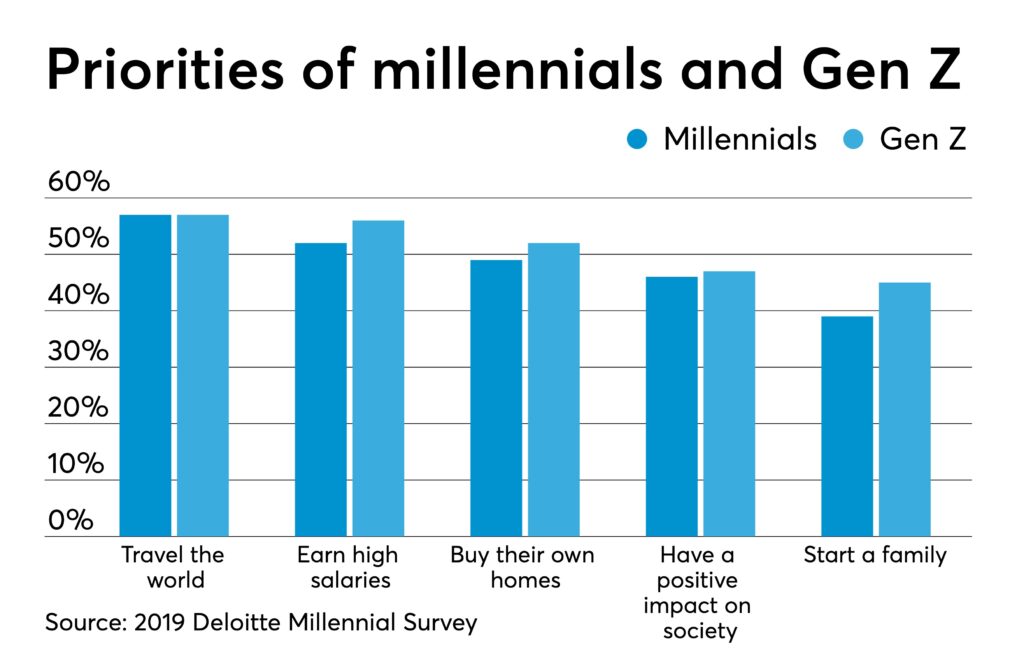Gen Z workers are becoming increasingly prevalent in the workforce: According to Bureau of Labor Statistics (BLS) data, there were 21 million workers in the US between the ages of 16 and 24 by July 2022, with the employment rate increasing by 54.4% annually. And as kids become older, the side business is probably going to gain recognition and popularity.
Pursuing passion projects and numerous sources of income may eventually prove to be one of the most important ways that the youngest generation in the profession differs from older generations.

Before the epidemic, there were side businesses, but they were frequently formed out of necessity rather than desire. These have appeared in the gig economy over the last few years, either in place of full-time positions or as a way to supplement income.
Many people still need side jobs to augment their income. According to a September 2022 study of 4,000 UK workers conducted by the insurance company Royal London, 16% of respondents had taken on a second job to assist pay for rising costs of living.
“The stacking of occupations has always existed, but it has typically been done by workers who have needed it as a means of economic survival,” argues Meredith Meyer Grelli, assistant teaching professor of entrepreneurship at Carnegie Mellon University’s Tepper School of Management in Pittsburgh, US.
A new type of side business has evolved for knowledge workers due to the changing nature of employment, even though the layering of jobs will continue to be a reality for some segments of the workforce. By implementing flexible work schedules, employees have more freedom to pursue side hustles and earn extra money out of choice rather than necessity.
Without a full-time office environment, there is less visibility on the employee, according to Caroline Frankum, Head of Kantar’s Profiles division in London. Together with less rigid and structured work schedules, shorter commutes have made it possible for more people to pursue side businesses.
44% of Americans now earn a side income, up 13% from two years ago. Gen Z, Millennials, and Gen Xers make up the majority of workers in side jobs. The typical side job earns $473 per month, or $5,700 annually. #ThursdayMotivation #Freelancer #work https://t.co/tz0HIfGKYO
— Flexgigzz (@Flexgigzz_team) February 23, 2023
As a result, even workers in highly compensated full-time professions now want a second source of income. “Side hustles have appealed to a different level of worker and competence after the pandemic,” explains Meyer Grelli. These individuals are at a higher level in the employment value chain and can now mix jobs and side hustles to make the most of their abilities and money.
One major factor is the growth of social media accounts designed for personal branding and online marketplaces like Shopify and Etsy that make it simple for employees to make money from their hobbies. According to Meyer Grelli, the model that workers who had to layer occupations adopted had made it possible for people in higher-paying jobs to adopt it themselves.
Although more workers are establishing side businesses, the movement is being driven by people who are just starting their professions. 40% of Gen Z employees are juggling at least two roles, according to a Kantar worldwide study of 10,000 workers conducted in February 2023.
In light of the current state of the economy and the rising cost of living, some of this is still being driven by financial reasons. We are always conscious of the fact that earning money requires more than a nine-to-five job, according to West. On social media, people claim that we require seven different sources of income.
Gen Z, however, finds side businesses more intriguing due to broader generational changes. “Career trajectories are becoming less linear,” says Caitlin Duffy, director of research at consultancy firm Gartner, based in Virginia, US. “Young workers are entering a volatile work environment. Rather than being forced to stay in one position for a longer period of time, they want to position themselves for long-term employability, remain adaptable, and be able to move between companies.”
According to Meyer Grelli, side businesses also spread risk. Younger people are aware that jobs and entire industries might disappear overnight. They often turn to their contemporaries, who are creating new avenues through risky side hustles that are amplified on digital platforms, while their parents’ generation’s careers are no longer necessarily stable possibilities.
Another important factor for Gen Z is the flexibility that side jobs offer. According to Meyer Grelli, “among the students I work with, there’s a perceived rigidity to a typical career: one told me they’d never dedicate their “full self” to work. Instead, they want to create a pathway that is more fairly distributed throughout their lifetimes. They grew up with flexibility because they are entering the workforce at a time when everything is changing.
Young people can invest in their passions through side businesses in addition to creating new sources of income. According to Meyer Grelli, “work is a source of identity for many”. A way for young individuals to find value is through passion projects, which allow those just starting out in their professions to explore and test interests and ideas outside of the conventional professional trajectory.
When done right, a side business can help young people thrive financially and personally. According to Meyer Grelli, one of her students is developing a start-up that would enable digital natives to manage several IT professions at once on their own schedule. It was motivated by his own experience over the past few years of being able to take on several digital tasks that he could complete from anywhere and fit them all into his schedule at once.
There are indications that employers are already growing more receptive of employees’ side businesses in the new workplace. According to Meyer Grelli, before the epidemic, employees were less receptive and willing to discuss anything that would take their focus away from their full-time employment, including child care. Nonetheless, businesses are increasingly more sympathetic and open to their employees’ deeper needs and desires, which includes their passion projects.

Employers may use side jobs as a retention strategy, but employees may also develop experience and skill sets that are immediately applied to their day jobs. Young workers today may expect a long career with room for growth and side jobs, according to Meyer Grelli. Instead of avoiding or stifling that, employers must discover out how to incorporate it into their own growth.
Due in part to her personal brand and freelance work, West has recently been upgraded in her full-time position to become a Gen Z engagement executive, serving as a point of contact for companies trying to target Gen Z audiences. She thinks employers will start to accept side jobs more frequently as they become more widespread.
“We’re a complex generation,” West continues. “My partner works as an accountant but also maintains an Instagram sneaker page. Companies who adopt this strategy will have young employees who can be themselves at work every day, contributing more expertise and clout to the company.
A successful side business can give employees a variety of experiences, skill sets, and income streams that further their professional goals. The risk of overworking is a concern, but West maintains that her 50-hour workweeks are worthwhile. “I’m passionate about my side businesses, so I don’t really consider them to be ‘work. I’m willing to put in the effort because I also know it will be beneficial for my future.
As more members of Generation Z join the workforce, side businesses are likely to become increasingly commonplace and possibly even a future workplace expectation.
Since the epidemic, “there has been a fundamental shift in what a job looks like,” adds Frankum, especially among younger people. Young workers are frequently motivated and driven by doing many things, being more meaningful at work, and furthering their education, all of which can be accomplished through a side hustle.




